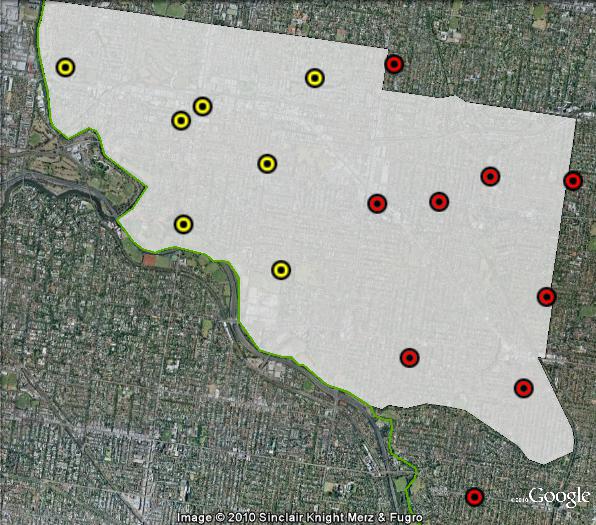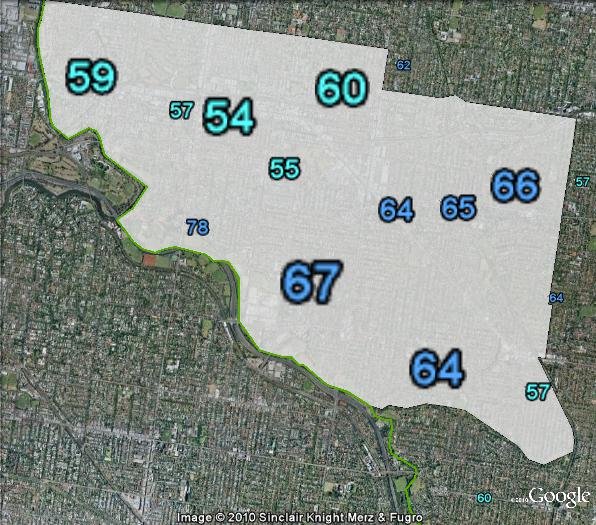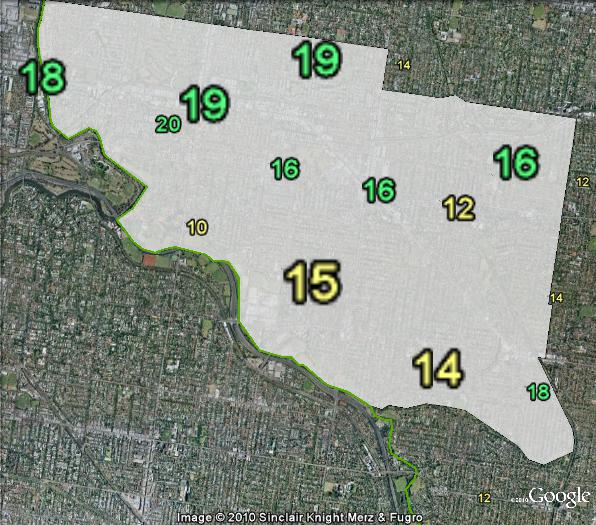LIB 12.3%
Incumbent MP
Ted Baillieu, since 1999.
Geography
Eastern Melbourne. Hawthorn covers southern parts of Boroondara local government area, and specifically the suburbs of Hartwell and Hawthorn and parts of the suburbs of Burwood, Camberwell, Canterbury and Glen Iris.
History
Hawthorn has existed as an electoral district continuously since 1889. In that time, it has been dominated by conservative MPs, and has only been won by the ALP at one election in 1952.
The seat was won in 1902 by George Swinburne. He ended up serving as a member of the Commonwealth Liberal Party before his retirement in 1913.
He was succeeded by William Murray McPherson. McPherson served as Treasurer in the Nationalist state government from 1917 to 1923, and as Premier from 1928 to 1929. McPherson resigned from Parliament in 1930.
He was succeeded by Nationalist candidate John Gray at the 1930 by-election. Gray served as Member for Hawthorn until his death in 1939.
His seat was won at the 1939 by-election by the United Australia Party’s Leslie Tyack. He lost the seat at the 1940 state election to independent candidate Leslie Hollins, who had links to the Social Credit movement.
Hollins held Hawthorn for two terms, losing in 1945 to the Liberal Party’s Frederick Edmunds. He also held the seat for two terms, until in 1950 the Liberal Party replaced him with his predecessor Leslie Tyack.
Tyack was defeated in 1952 by the ALP’s Charles Murphy, the only ALP member to ever win Hawthorn. He left the ALP in the split of 1955, and lost his seat at that year’s election to the Liberal Party’s James Manson.
After one term, Manson moved to the new seat of Ringwood in 1958, and was replaced in Hawthorn by Peter Garrisson. He was re-elected in 1961, but in 1963 he resigned from the Liberal Party, and lost his seat as an independent in 1964.
Walter Jona was elected as Liberal Member for Hawthorn in 1964. He served as a minister in the Liberal government from 1976 to 1982, and retired in 1985.
Hawthorn was won in 1985 by the Liberal Party’s Phillip Gude, who had previously held the seat of Geelong East for one term from 1976 to his defeat in 1979. He served as a minister in the Kennett government from 1992 until his retirement in 1999.
Since 1999, Hawthorn has been held by Ted Baillieu, who has served as Leader of the Opposition since May 2006.
Candidates
- John McNally (Labor)
- Ted Baillieu (Liberal)
- Jenny Henty (Greens)
- Peter Grounds (Family First)
Political situation
Hawthorn is a very safe Liberal seat, and that is unlikely to change at this year’s election.
2006 result
| Candidate | Party | Votes | % | Swing |
| Ted Baillieu | LIB | 18,860 | 56.06 | +6.39 |
| John McNally | ALP | 8,647 | 25.70 | -4.82 |
| Lynda Birch | GRN | 5,467 | 16.25 | -3.56 |
| Veronica Sidhu | FF | 667 | 1.98 | +1.98 |
2006 two-candidate-preferred result
| Candidate | Party | Votes | % | Swing |
| Ted Baillieu | LIB | 20,941 | 62.26 | +6.38 |
| John McNally | ALP | 12,694 | 37.74 | -6.38 |
Booth breakdown
Booths in Hawthorn have been divided into two areas: those in the west of the seat around Auburn and Glenferrie, and those in the east around Camberwell.
The Liberal Party won a majority of over 60% in both areas, although Baillieu won a larger majority in the Camberwell area. The Greens polled better in the eastern end of the seat, with almost 17%, compared to 14.5% in the Camberwell area.

| Voter group | GRN % | LIB 2CP % | Total votes | % of votes |
| Auburn-Glenferrie | 16.89 | 60.79 | 14,118 | 41.97 |
| Camberwell | 14.55 | 63.54 | 10,919 | 32.46 |
| Other votes | 17.36 | 63.05 | 8,598 | 25.56 |




Labor came close here in the 1980s but were not close even in 2002, seems to have become much more affluent in recent decades.
In the Age on Saturday the 9th of October there was a table with the 2010 Commonwealth primaries for several inner city seats. The Hawthorn primaries were Greens 20.3%, ALP 27.1% and Liberal 52.6%.
That’s fairly weird… it’d produce a Lib margin a lot less than Hawthorn in 2006, probably around 7-8%. A possible cause could be more of a Labor / Green campaign to win the federal seat, but that doesn’t make much sense considering that seat is Kooyong.
Also, the Libs did notably badly at the 2010 federal election in Vic… thing is, they also did so at the 2006 Vic state election. Hmm.
BoP,
I’m guessing the leadership factor gave Baillieu a boost? 6%+ was a decent swing in 2006.
Candidates in ballot paper order are:
John McNally – Labor
Ted Baillieu – Liberal
Jenny Henty – Greens
Peter Grounds – Family First
It’s time that Hawthorn electorate was redistributed to take the form of its 1970’s boundaries. The 1970’s electorate took in the eastern part of Richmond, Hawthorn, Hawthorn East, and the north western part of Glen Iris, none of the suburbs to the east of Burke Road (namely Camberwell, and Canterbury) were included. This would halt the right ward shift this electorate is taking each election. In 1982 Hawthorn was a marginal Liberal seat, but since then it has swung more and more rightwards, even when the rest of Melbourne was swinging to the A.L.P. It has passed Kew, Malvern, and Brighton in being the most right wing seat in metropolitan Melbourne. It now has the dubious honor of being the strongest Liberal voting electorate in metropolitan Melbourne. If the boundaries shifted westward to take in part of Labor/ Greens voting Richmond, Baillieu would be given a run for his money. Who knows he may even lose his seat. Brighton electorate takes in the Labor/ Greens voting Elwood, and Labor voting Highett, and Malvern takes in the Labor voting part of Malvern East that used to be part of Chadstone until the late 1980’s, so it is only fair that the electorate of Hawthorn take in a Labor voting area to make things more interesting.